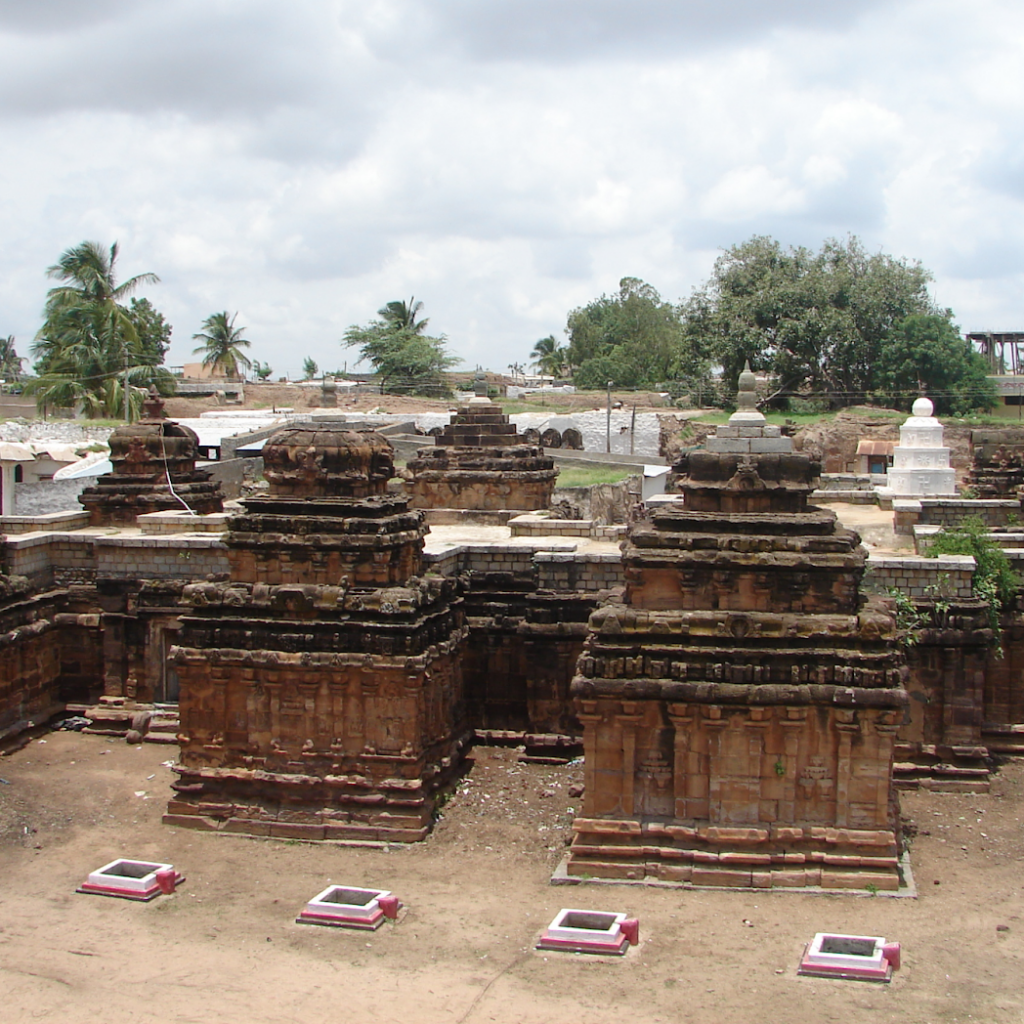South Indian temple architecture is a rich and intricate tradition that has evolved over centuries, reflecting the cultural, religious, and artistic diversity of the region. Characterized by towering gopurams (entrance towers), intricate carvings, and vast courtyards, these temples are not merely places of worship but also architectural marvels. One of the distinctive features is the Dravidian style, marked by pyramidal towers adorned with elaborate sculptures depicting mythological narratives, deities, and celestial beings. The intricate craftsmanship extends to the detailed carvings on pillars, walls, and ceilings, showcasing a mastery of stone artistry. Another noteworthy aspect is the emphasis on axial and symmetrical planning, creating a harmonious spatial arrangement. South Indian temples often have spacious halls, known as mandapas, where religious ceremonies and cultural events take place. The temple complexes are designed to engage the senses, with vibrant colors, aromatic incense, and rhythmic rituals creating a spiritual atmosphere. Each element of the architecture carries symbolic meaning, reflecting the profound philosophical and religious concepts embedded in Hinduism. South Indian temple architecture stands as a testament to the enduring legacy of art and spirituality, captivating both devotees and admirers of architectural excellence alike.
Contents
- 1 Chalukyan architecture
- 2 Rashtrakuta architecture
- 3 Hoysala temple architecture
- 4 Vijayanagara architecture
- 5 FAQs
- 5.1 FAQ 1: What is South Indian temple architecture, and what are its key features?
- 5.2 FAQ 2: How do South Indian temples differ from North Indian temples in terms of architecture?
- 5.3 FAQ 3: Can you provide information about the famous Meenakshi Temple in South India?
- 5.4 FAQ 4: What are some other notable South Indian temples known for their architecture and historical significance?
- 5.5 FAQ 5: Can you list some traditional South Indian temple names and their locations?
- 5.6 For Admissions, talk to our Mentor – 9811333901, 9811333782
Chalukyan architecture
The Chalukyan architecture is a blend of Nagara and Dravidian styles and can be observed in temples built in Aihole, Badami, and Pattadakal. These temples lack a covered ambulatory path. The Virupaksha temple in Pattadakal, modeled after the Kailashnath temple, is considered the masterpiece of Chalukyan architecture. Additionally, the Rameshwaram temple in Ellora, constructed during the 7th century, was also built during the Chalukyan era. Noteworthy monuments built during this period include the Lad Khan temple and Durga temple in Aihole.

Rashtrakuta architecture
The successors of the Chalukyas built temples that mostly imitated the Chalukyan style. The Kailas temple at Ellora, constructed during the reign of Krishna II, is a representative example of the architecture of this empire. Another temple built during this period is the Navalinga Temple in Kukkanur.

Hoysala temple architecture
The Kesava temple in Belur was constructed during the reign of Vishnuvardhana to celebrate his victory over the Cholas and represent the art of this era. It features numerous shrines arranged in a central pillared hall in the form of a complex star-shaped design. Similar designs can be found in other temples of the period, such as in Halebid and Somnathpur. Another well-known temple from this period is the Hoysaleswara temple, which is dedicated to Lord Shiva.
Vijayanagara architecture
The Vijayanagar style of architecture is a lively blend of Chalukya, Hoysala, Pandya, and Chola styles. The use of local hard granite as the primary building material is reminiscent of the Badami Chalukyas. These temples are distinguished by their elaborate pillared halls and towering rayagopurams adorned with life-sized sculptures of deities, which are located at the temple entrance. The carved pillars of Vijayanagar temples are also noteworthy, featuring charging horses, figures from Hindu mythology, and yali (hippogriphs). Many of the larger temples have separate shrines for the male and female deities. The Virupaksha Temple in Hampi and the Hazara Rama Temple of Deva Raya I are among the well-known temples that showcase the Vijayanagar style.


FAQs
FAQ 1: What is South Indian temple architecture, and what are its key features?
Answer: South Indian temple architecture is a style of temple construction primarily found in the southern region of India. Its key features include a tall, pyramidal tower (gopuram) at the entrance, intricate sculptures, use of Dravidian architectural elements, and a rectangular layout with a central sanctum. These temples often have intricate carvings depicting mythological stories and deities.
FAQ 2: How do South Indian temples differ from North Indian temples in terms of architecture?
Answer: South Indian temples, in contrast to North Indian temples, typically have a more ornate and towering entrance gopuram, a rectangular layout, and a single sanctum. North Indian temples are characterized by a shikhara or spire, a square layout, and multiple sanctums.
FAQ 3: Can you provide information about the famous Meenakshi Temple in South India?
Answer: The Meenakshi Temple, located in Madurai, Tamil Nadu, is one of the most renowned South Indian temples. It is dedicated to Goddess Meenakshi (a form of Parvati) and Lord Sundareswarar (a form of Shiva). The temple’s gopurams (towers) are elaborately carved and painted with vibrant colors, making it a masterpiece of South Indian temple architecture.
FAQ 4: What are some other notable South Indian temples known for their architecture and historical significance?
Answer: Besides the Meenakshi Temple, other notable South Indian temples include Brihadeeswarar Temple (Thanjavur), Padmanabhaswamy Temple (Thiruvananthapuram), Chennakesava Temple (Belur), and Virupaksha Temple (Hampi). These temples are famous for their intricate carvings, unique architecture, and cultural importance.
FAQ 5: Can you list some traditional South Indian temple names and their locations?
Answer: Certainly! Here are a few traditional South Indian temple names and their respective locations:
- Brihadeeswarar Temple – Located in Thanjavur, Tamil Nadu.
- Meenakshi Temple – Situated in Madurai, Tamil Nadu.
- Padmanabhaswamy Temple – Found in Thiruvananthapuram, Kerala.
- Virupaksha Temple – Located in Hampi, Karnataka.
- Ramanathaswamy Temple – Situated in Rameswaram, Tamil Nadu.
For UPSC Prelims Resources, Click here
For Daily Updates and Study Material:
Join our Telegram Channel – Edukemy for IAS
- 1. Learn through Videos – here
- 2. Be Exam Ready by Practicing Daily MCQs – here
- 3. Daily Newsletter – Get all your Current Affairs Covered – here
- 4. Mains Answer Writing Practice – here
Visit our YouTube Channel – here


